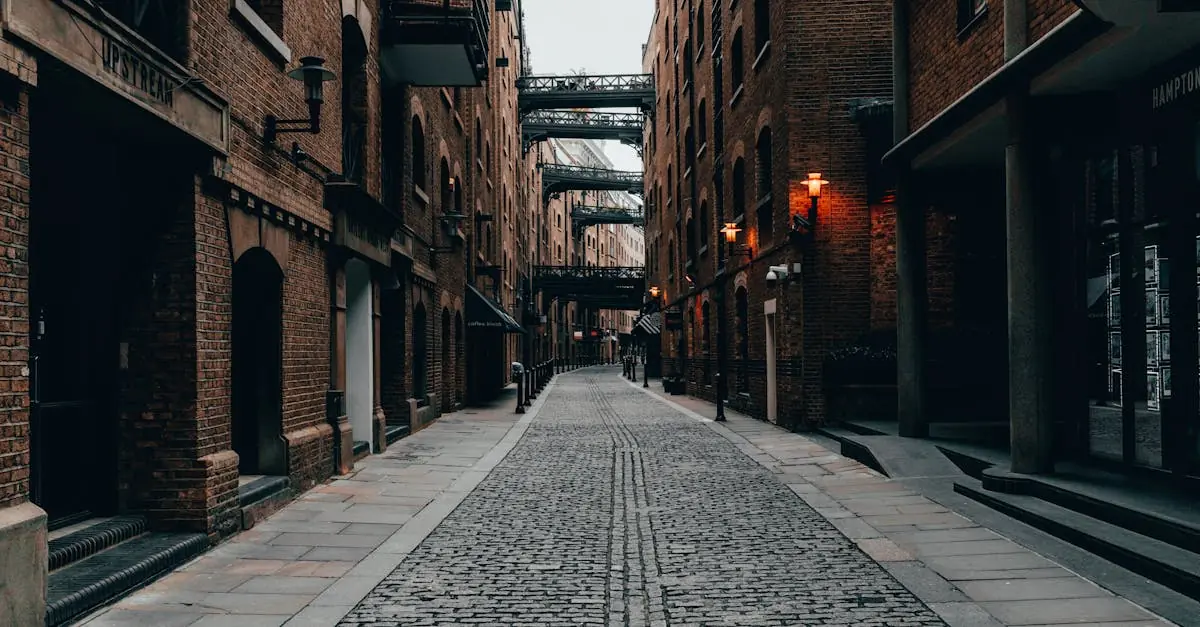As night falls, cities transform into shimmering landscapes, but those glowing streetlights don’t just look pretty—they can also drain the budget faster than a kid with a candy bar. Enter low-energy street lighting, the superhero of urban illumination. It’s like swapping a gas-guzzler for a sleek electric car, but for your neighborhood’s glow.
Table of Contents
ToggleOverview of Low-Energy Street Lighting
Low-energy street lighting incorporates advanced technologies to reduce energy consumption while enhancing urban illumination. LED fixtures represent a significant shift, using up to 75% less energy compared to traditional streetlights. These fixtures emit brighter light with better directional control, minimizing light pollution and power waste.
Cities adopting low-energy street lighting often experience reduced operational costs. An average yearly savings can amount to thousands of dollars per streetlight when energy-efficient solutions are utilized. Enhanced lifespan is another advantage; LED lights typically last 25,000 to 50,000 hours, drastically reducing maintenance requirements.
Environmental benefits play a crucial role in this transition. Decreased energy demand lowers greenhouse gas emissions, which positively impacts air quality. Many municipalities now view low-energy street lighting as part of broader sustainability initiatives aimed at reducing overall carbon footprints.
Moreover, smart technologies can be integrated into low-energy systems, allowing for remote monitoring and control. Sensors detect pedestrian movement, enabling lights to brighten or dim based on activity levels, further optimizing energy use. The implementation of smart lighting solutions fosters an intelligent urban infrastructure, paving the way for future advancements.
In sum, low-energy street lighting stands out as a forward-thinking approach to urban planning. Sustainability, cost-effectiveness, and enhanced safety combine, making it an appealing choice for cities aiming to modernize their nighttime environments.
Benefits of Low-Energy Street Lighting
Low-energy street lighting significantly enhances urban environments in multiple ways. It addresses both environmental and economic concerns while making cities safer and more efficient.
Environmental Impact
Low-energy street lighting reduces energy consumption, leading to lower greenhouse gas emissions. This reduction in energy demand directly contributes to the mitigation of climate change. Utilizing LED technology decreases light pollution, allowing for better visibility of stars and reducing the disruption to local wildlife. Municipalities implementing these systems notice improvements in air quality due to less reliance on fossil fuels. Additionally, many cities align these initiatives with broader sustainability goals to lessen their overall carbon footprints, demonstrating a commitment to environmental stewardship.
Economic Advantages
Significant cost savings arise from the adoption of low-energy street lighting. Municipalities report operational savings of up to $500 or more annually per streetlight when switching to LED fixtures. Reduced energy bills contribute to these savings, enhancing budget flexibility for other essential services. Longer lifespans of 25,000 to 50,000 hours minimize maintenance expenses and decrease the frequency of replacements. Cities using smart technologies for adaptive lighting further optimize energy usage, ensuring lights operate only when needed. Overall, these economic benefits provide a strong incentive for local governments to adopt low-energy street lighting solutions.
Types of Low-Energy Street Lighting
Low-energy street lighting encompasses various technologies designed to reduce energy consumption and enhance urban environments. Two prominent types include LED technology and solar-powered solutions.
LED Technology
LED technology plays a critical role in low-energy street lighting. Fixtures utilize light-emitting diodes to produce bright illumination while consuming 75% less energy compared to traditional methods. Municipalities experience operational cost savings, with potential annual savings over $500 per streetlight. Lifespan ranges between 25,000 and 50,000 hours, minimizing maintenance and replacement frequency. Directional control reduces light pollution, enhancing nighttime visibility. Modern upgrades to smart features enable adaptive lighting based on pedestrian activity, optimizing energy use further. These attributes illustrate why cities are increasingly prioritizing LED solutions for sustainable urban development.
Solar-Powered Solutions
Solar-powered solutions provide another effective approach to low-energy street lighting. These systems harness sunlight through photovoltaic panels, converting it into electricity for nighttime illumination. Environmental sustainability emerges as a key benefit, as these solutions significantly lower reliance on fossil fuels. Installation often requires minimal infrastructure, making them suitable for remote or underserved areas. Newer models include battery storage, ensuring reliable lighting even during cloudy weather. As cities continue to emphasize sustainability and resilience, solar-powered street lighting becomes increasingly attractive, supporting diverse municipal energy initiatives.
Challenges and Considerations
Low-energy street lighting presents several challenges that municipalities must navigate. Both initial costs and maintenance factors weigh heavily on decision-making.
Initial Costs
Initial costs for low-energy street lighting systems can pose barriers for municipalities. Investment in LED fixtures or solar-powered solutions requires upfront funding, which may strain budgets. Despite these costs, the long-term savings from reduced energy bills can offset initial investments. Additionally, many cities find financial incentives and government rebates available to ease the transition. These potential savings make such systems attractive, showcasing how smart investments today can lead to financial benefits down the line.
Maintenance Factors
Maintenance factors significantly influence the adoption of low-energy lighting. While LED fixtures offer longer lifespans, cities must still consider eventual replacement and repair costs. Robust monitoring systems play a crucial role in identifying issues early, minimizing downtime. Regular evaluations can help optimize performance and prolong lifespan, leading to reduced maintenance needs. Moreover, integrating smart technologies allows municipalities to proactively address maintenance challenges, ensuring consistent reliability and efficiency throughout the lighting system’s life cycle.
Conclusion
Low-energy street lighting presents a transformative opportunity for municipalities aiming to enhance urban environments while prioritizing sustainability. By adopting LED and solar-powered solutions, cities can significantly reduce energy consumption and operational costs.
The integration of smart technologies further optimizes these systems, ensuring efficient performance and proactive maintenance. As cities navigate the challenges of initial investments and maintenance considerations, the long-term benefits of low-energy lighting become increasingly evident.
Ultimately, this approach not only supports economic savings but also contributes to a healthier planet, making low-energy street lighting a vital component of modern urban planning.







